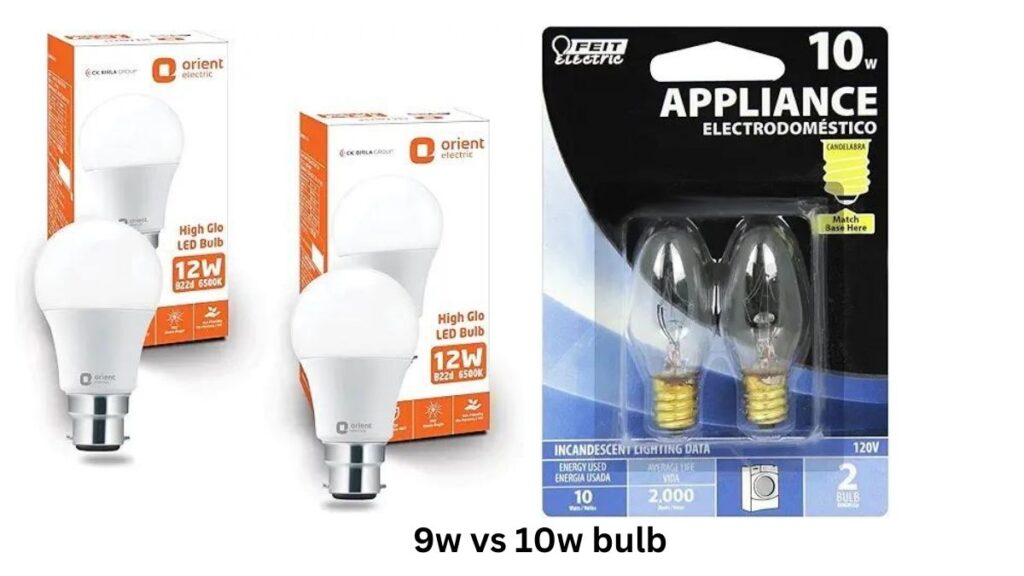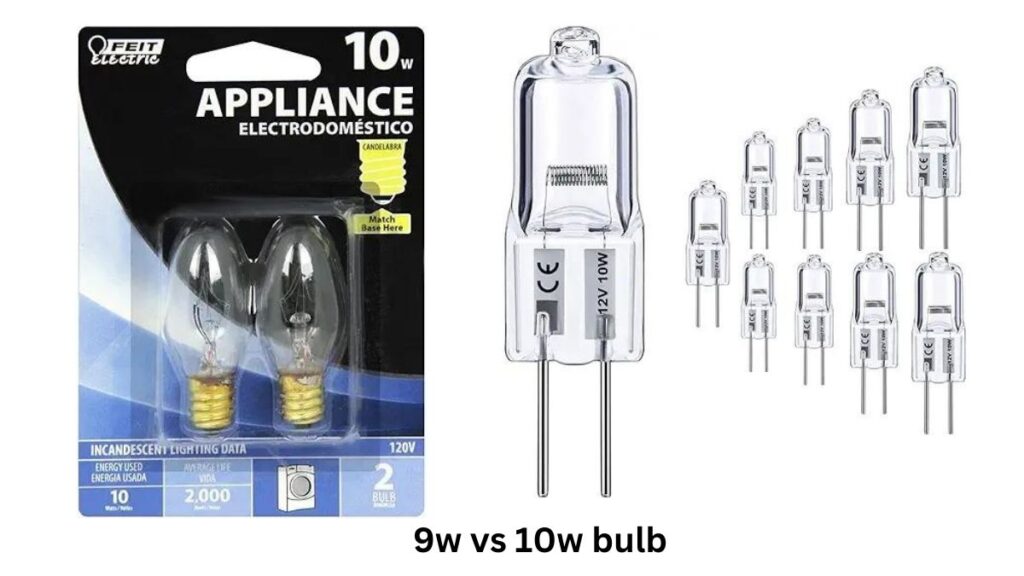Get best and affordable SYLVANIA ECO LED Light Bulb: Check now
Choosing the right light bulb is more important than ever. With advancements in lighting technology, even a small difference in wattage can make a significant impact on your energy consumption, brightness, and overall lighting experience. If you’re comparing a 9W bulb with a 10W bulb, the difference may seem minor at first glance. But in reality, it can influence factors like brightness, cost efficiency, and environmental impact.
In this article, we’ll break down the difference between 9W and 10W bulbs, focusing on their performance, energy consumption, and more. We’ll also explore how this comparison fits into the broader world of energy-efficient lighting.
Understanding Wattage: More Than Just a Number
Wattage refers to the amount of energy a bulb uses to produce light. The amount of electricity used by the lightbulb increases with its wattage. Traditionally, people used wattage to measure brightness – the more watts, the brighter the bulb. However, with the rise of energy-efficient LED bulbs, this relationship has changed.
Today, lumens (a measure of light output) have become the standard for determining brightness, while wattage primarily reflects energy consumption. For example, both 9W and 10W LED bulbs produce a similar amount of light but consume different amounts of electricity.
The shift from wattage to lumens is essential because it helps you make better decisions based on energy savings and brightness needs. When comparing bulbs, it’s crucial to look at both wattage and lumens to ensure you’re getting the desired brightness with minimal energy usage.
9W Bulbs: The Energy-Saving Champs
9W LED bulbs are designed for maximum efficiency, making them a top choice for energy-conscious consumers. Despite their low wattage, these bulbs offer impressive brightness levels.
1. Typical Brightness Levels of 9W Bulbs
A 9W LED bulb typically produces between 800 and 900 lumens, which is comparable to a 60W incandescent bulb. This makes them perfect for general lighting in most residential areas like living rooms, bedrooms, and kitchens.
2. Common Applications and Ideal Spaces for 9W Bulbs
9W bulbs are ideal for spaces that don’t require extremely bright light but still need adequate illumination. They’re commonly used in lamps, ceiling fixtures, and downlights. These bulbs work best in medium-sized rooms or areas where energy savings are a priority, like hallways or bathrooms.
3. Energy Efficiency and Cost Savings Over Time
The real appeal of 9W bulbs lies in their energy efficiency. Switching from traditional incandescent bulbs to a 9W LED bulb can significantly reduce your electricity bill. Over time, you’ll save on energy costs, and the bulb’s long lifespan means fewer replacements, making it a cost-effective lighting solution.
10W Bulbs: A Slight Boost in Brightness
While the difference between 9W and 10W might seem small, a 10W bulb provides a slight boost in brightness, which can be helpful in specific situations.
i). Brightness Comparison Between 10W vs 9W Bulbs
A 10W LED bulb typically produces around 900-1,000 lumens. The extra watt translates to more light, which can make a noticeable difference in areas that require higher brightness, such as kitchens, workspaces, or outdoor lighting.
ii). Scenarios Where the Extra Watt Makes a Difference
In spaces where task lighting is essential, like home offices or kitchens, a 10W bulb’s additional brightness can enhance visibility. It’s also a good choice for outdoor lighting where brighter illumination is needed for security or curb appeal.
iii). )Energy Consumption and Long-Term Cost Considerations
Though a 10W bulb consumes more energy than a 9W bulb, the difference in electricity usage is minimal over time. The small increase in energy consumption may be worth it for those who prefer a brighter environment. However, if energy savings are your top priority, sticking with 9W might be the better choice.
Lumens vs Watts: The Modern Metric for Brightness
As mentioned earlier, lumens have replaced watts as the go-to measurement for bulb brightness. Understanding lumens can help you make a more informed decision when choosing between 9W and 10W bulbs.
a). Explanation of Lumens and Why It’s Becoming the Standard
The entire amount of visible light that a lightbulb emits is measured in lumens. Higher lumens mean a brighter bulb, regardless of wattage. This shift is particularly useful for LED bulbs, which use far less energy to produce the same amount of light as traditional bulbs.
b). Typical Lumen Outputs for 9W and 10W Bulbs
- 9W Bulb: 800-900 lumens
- 10W Bulb: 900-1,000 lumens
While the difference may seem small, choosing the right lumens ensures you get the desired brightness without overusing energy.
c). How to Use Lumens to Compare Bulb Brightness Accurately
When shopping for bulbs, focus on the lumen output rather than just wattage. A bulb with higher lumens will provide more light, making it the better option for spaces that require enhanced visibility.
Environmental Impact: Every Watt Counts
When it comes to environmental impact, even a single watt can make a difference. Choosing a lower wattage bulb can reduce your carbon footprint over time, especially if you multiply this by the number of bulbs in your home.
Carbon Footprint Comparison Between 9W and 10W Bulbs
The energy savings from a 9W bulb over a 10W bulb might seem insignificant on a daily basis, but over time, it adds up. Using 9W bulbs in every room of your house can lead to reduced energy consumption and lower carbon emissions.
Long-Term Environmental Benefits of Choosing Lower Wattage
Opting for 9W bulbs can help reduce overall energy demand, leading to fewer fossil fuels being burned to generate electricity. This contributes to a greener planet and helps combat climate change.
The Role of LED Technology in Reducing Energy Consumption
Both 9W and 10W bulbs use LED technology, which is far more energy-efficient than older incandescent or fluorescent options. LED bulbs last longer, consume less energy, and produce less heat, making them a more eco-friendly choice.
Cost Analysis: 9W vs 10W Over Time
Cost is a crucial factor when choosing between 9W and 10W bulbs, both in terms of upfront price and long-term energy savings.
Initial Purchase Price Comparison
The price difference between 9W and 10W bulbs is usually minimal. Both options are relatively affordable, with price variations depending on the brand and any additional features like dimming or smart capabilities.
Energy Cost Differences Over a Year and Bulb Lifetime
A 9W bulb will cost slightly less to run over time compared to a 10W bulb. While the difference may not be huge, the savings can add up, especially in homes with multiple bulbs.
Factoring in Replacement Frequency and Long-Term Savings
LED bulbs, whether 9W or 10W, have long lifespans – often lasting up to 25,000 hours or more. This means fewer replacements and reduced waste, further contributing to long-term savings.
Making the Right Choice: Factors to Consider
Ultimately, choosing between a 9W and 10W bulb depends on your specific lighting needs.
Room Size and Lighting Requirements
For smaller rooms or areas that require softer lighting, a 9W bulb is more than sufficient. For larger spaces or areas where brightness is crucial, like kitchens or garages, a 10W bulb might be the better option.
Color Temperature and Ambiance Preferences
Both 9W and 10W bulbs come in a range of color temperatures, from warm white to cool daylight. Consider the mood you want to create in each room when selecting your bulb.
Dimming Capabilities and Compatibility
If you’re using dimmer switches, check that your 9W or 10W bulb is compatible. Many LED bulbs offer dimming features, which can help you customize the brightness to suit your needs.
Conclusion: Lighting the Way Forward
In conclusion, while the difference between 9W and 10W bulbs may seem small, it can make a significant impact over time. Whether you’re looking to save on energy costs, reduce your environmental footprint, or simply brighten up your space, both options have their merits.
For energy-conscious consumers, the 9W bulb is a fantastic choice for its efficiency and cost savings. On the other hand, if brightness is your priority, a 10W bulb provides that extra boost without consuming too much additional power.
So, whether you’re lighting up your home or upgrading your current bulbs, both the 9W and 10W options offer great performance and efficiency. Choose wisely based on your room’s needs and personal preferences, and start enjoying the benefits of energy-efficient lighting today.
And if you’re ready to make the switch, why not check out some of the best 9W and 10W LED bulbs available online? They’re eco-friendly, cost-effective, and perfect for brightening up any space!
Get 10 pack halogen 10w bulb with G4 pin base: Get Now
Related articles:
Hi, I’m Malik Suhail—an SEO expert, web designer, and passionate blogger with 2 years of experience. I specialize in crafting content that is not only informative but also tailored to meet the needs of my readers.
I write about diverse topics, always striving to simplify complex ideas and provide valuable insights that resonate with my audience. Whether it’s about SEO strategies, web design trends, or blogging tips, I am committed to delivering well-researched, practical, and easy-to-understand information.
My mission is to help readers navigate the digital world with confidence and clarity. I believe in adding value through authentic content that inspires action and delivers results.


